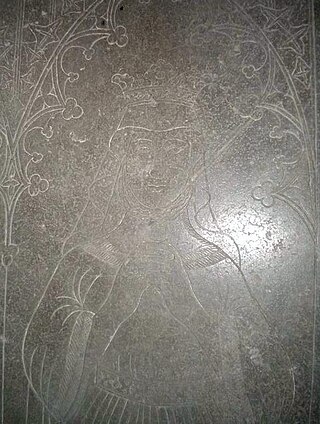Related Research Articles

Margaret I was Queen regnant of Denmark, Norway, and Sweden from the late 1380s until her death, and the founder of the Kalmar Union that joined the Scandinavian kingdoms together for over a century. She had been queen consort of Norway from 1363 to 1380 and of Sweden from 1363 to 1364 by marriage to Haakon VI. Margaret was known as a wise, energetic and capable leader, who governed with "farsighted tact and caution," earning the nickname "Semiramis of the North". Also famous derisively as "King Breechless", one of several derogatory nicknames once thought to have been invented by her rival King Albert of Sweden, she was also known by her subjects as "Lady King", which became widely used in recognition of her capabilities. Knut Gjerset calls her "the first great ruling queen in European history."

Valdemar II Valdemarsen, later remembered as Valdemar the Victorious, was King of Denmark from 1202 until his death in 1241.

Valdemar I Knudsen, also known as Valdemar the Great, was King of Denmark from 1154 until his death in 1182. The reign of King Valdemar I saw the rise of Denmark, which reached its medieval zenith under his son King Valdemar II.

Valdemar IV Atterdag, or Waldemar was King of Denmark from 1340 to 1375. He is mostly known for his reunion of Denmark after the bankruptcy and mortgaging of the country to finance wars under previous rulers.

Valdemar or Waldemar was King of Sweden from 1250 to 1275.
Richeza of Poland, a member of the House of Piast, was twice Queen of Sweden and once Princess of Minsk through her three marriages.
Sverker II or Sverker the Younger was King of Sweden from 1195 or 1196 to 1208 when he was defeated in the Battle of Lena by Prince Eric. Sverker died in the 1210 Battle of Gestilren where his forces battled those of King Eric X.

Sverker I or Sverker the Elder was King of Sweden from about 1132 until his murder. Of non-royal descent, he founded the House of Sverker, the rulers of which alternated with the rival House of Eric over the next century.

Ingeborg of Norway, was a Norwegian princess and by marriage a Swedish royal duchess with a position in the regency governments in Norway (1319–27) and Sweden (1319–26) during the minority of her son, King Magnus of Norway and Sweden. In 1318–1319, she was Sweden's de facto ruler, and from 1319 until 1326, she was Sweden's first de jure female regent. Her role in northern European history is considered of major importance.
Duke Benedict of Halland and Finland, aka Bengt Algotsson, was a medieval Swedish lord, and royal favourite.
Svantepolk Knutson was a Swedish knight and councilor. He became a wealthy feudal lord in Östergötland.

Sophia of Denmark was Queen of Sweden as the consort of King Valdemar.

Richeza of Denmark was Queen of Sweden as the wife of King Eric X, and the mother of King Eric XI.

Kirsten Munk was a Danish noble, the second spouse of King Christian IV of Denmark, and mother to twelve of his children.

Sophia of Minsk or Sophia of Polotsk was a Danish queen consort by marriage to King Valdemar I of Denmark, and a landgravine of Thuringia by marriage to Louis III, Landgrave of Thuringia.

Matilda of Holstein or Mechthild was a Danish queen consort, married to King Abel of Denmark and later to Birger Jarl, Regent of Sweden.

Princess Marie of Orléans was a French princess by birth and a Danish princess by marriage to Prince Valdemar. She was politically active by the standards of her day.

Helvig of Schleswig was the queen of Denmark as the spouse of King Valdemar IV. She was the mother of Queen Margaret I of Denmark.

Princess Christina Ingesdotter of Sweden was a Swedish princess and a princess consort of Veliky Novgorod, Rostov and Belgorod, by marriage to Grand Prince Mstislav I of Kiev.
Ingeborg of Denmark was the eldest daughter of Valdemar IV of Denmark and his wife Helvig of Schleswig. By marriage she was Duchess of Mecklenburg, although she died before her husband succeeded her father-in-law. She was potential heiress to the Danish throne and was the older sister of Margaret I of Denmark.